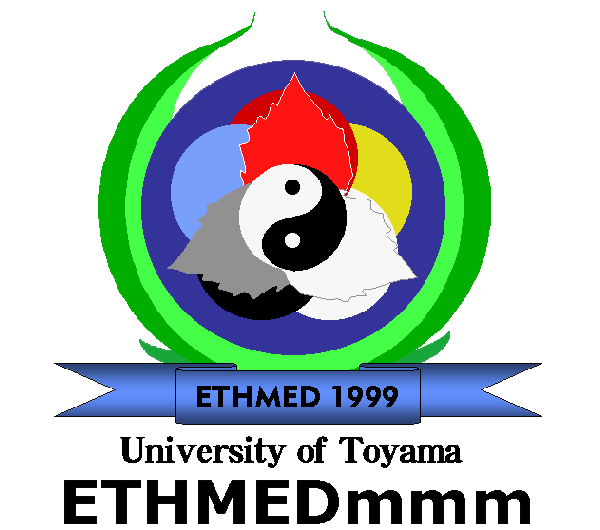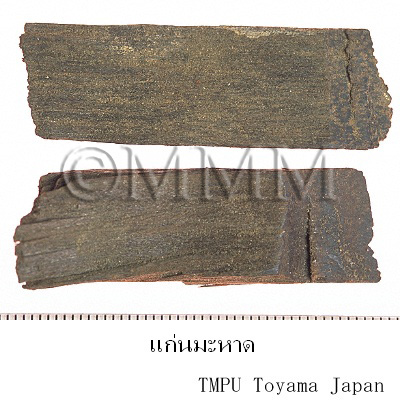Crude drug sample data base
※Click on the image to enlarge it.
The capital city, provincial capital city or the representative
location of its administrative area is indicated.
location of its administrative area is indicated.
Production area information
https://ethmed.toyama-wakan.net/img/pin_san.png
13.7563309
100.50176510000006
Collection information
Kingdom of Thailand,Bangkok
https://ethmed.toyama-wakan.net/img/pin_nyu.png
Scientific information data base
| Crude drug name | Thai name, English name | Ma-hat | ||||
|---|---|---|---|---|---|---|
| crude drug image |
| |||||
| Original plant name | Artocarpus lacucha Roxb. ex Buch-Ham. syn. Artocarpus lakoocha Roxb., Artocarpus dadah Miq. | |||||
| Family name | Moraceae | |||||
| Used part | Root, bark, wood, latex, wood extract (Puak-hat) | |||||
| Distribution area | Common in evergreen and gallery or mixed deciduous forests in the southern, southwestern and southeastern of Thailand, as well as in semi-open areas of northern Thailand. Also found in Sri Lanka, India, Myanmar, Malay Peninsula, Sumatra and Borneo. | |||||
| Frequency in use | Moderate | |||||
| Traditional usage | Root: antipyretic, vermifuge, a remedy for nephritic complications. Bark: antipyretic, vermifuge, for round worms, threadworms, and tapeworms. Heartwood: hot taste, a remedy for nephritic complications, fainting, anti-emetic, anti-coaggulating, laxative and antivesicular pruritic. Wood: antivesicular pruritic, antidyspeptic, for treatment of skin diseases, and intestinal parasitic infections (tapeworms and threadworms). Latex: stomachic, a remedy for threadworm infection. Dried aqueous extract of wood ("Puak hat"): hot and nauseating taste, vermifuge for threadworms, roundworms and tapeworms, for treatment of skin diseases such as vesicular pruritis. | |||||
| Drug effect | Antipyretic, Vermifuge, Antipruritic. | |||||
| Chemical constituent | Afzelechin-3-O-α-L-rhamnopyranoside; (-)-epiafzelechin; lympho-agglutinin; norartocarpetin; artocarpin; Artocarpus isolectins ALA-I and ALA-II; (+)-catechin; epiafzelechin-(4beta-->8)-epicatechin; dadahols A and B; engeletin; 5,7-dihydroxy-flavone-3-O-α-L- rhamnoside; 5-hydroxy-7,2',4'-trimethoxy-flavone; galangin-3-O-β-D-galactostl-(1-->4)- α-L- rhamnoside; gemichalcone B; isogemichalcone B; kaempferol-3-O-β-D-xylopyranoside; lakoochins A and B; lupeol; dihydromorin; moracin M; 3-(γ,γ-dimethylpropenyl)moracin M; quercetin-3-O-α-L- rhamnopyranoside; resveratrol; oxyresveratrol; 3-(γ,γ-dimethylallyl)resveratrol; 5-(γ,γ-dimethylallyl)oxyresveratrol; 3-(2,3-dihydroxy-3-methylbutyl)resveratrol; β-sitosterol; steppogenin; 2,3',4,5'-tetrahydroxystilbene; 2,4,3',5'- tetrahydroxystilbene. | |||||
| Pharmacological effect | Hypotensive, antiviral against phytopathogenic virus, herpes simplex viruses (HSV-1 and HSV-2), and a wild-type human immunodeficiency virus type 1 (HIV-1/LAI), antibacterial, anti-mycobacterial, clinical effective against Taenia saginata, inhibitory against cyclooxygenases 1 and 2 (COX-1 and COX-2), cytotoxic to cancer cells. | |||||
| Medical system | Thai medicine | |||||
| Preparations | Oral and topical solutions or suspensions. | |||||
| Side effect | Not found on an acute toxicity study in mice and rats. Fatigue may be anticipated from anthelmintic application in combination with other cathartic. A case report of allergic transient effects occurred as pyrexia, and the redness of the face, skin, and eyes. | |||||
| References | Reference book Tips! | The Forest Herbarium of the Royal Forest Department: Thai Plant Names Tem Smitinand, Revised Edition 2001. Prachachon Co.Ltd., Bangkok. p 57. Wuttidhamvate W.: Saranukrom Samunplai, 1997. Odian Store Press, Bangkok. Ruangrungsi N and Manklakupta T.: Thai Herbs I. 2004. Thanprinting Co., Ltd., Bangkok. Brun V and Schumacher T.: Traditional Herbal Medicine in Thailand, 1994. White Lotus Co., Ltd., Bangkok. Gardner S, Sidisunthorn P, and Anusarnsunthorn V.: A Field Guide to Forest Tree of Northern Thailand, 2000. Kobfai Publishing Project, Bangkok. p 329, 451 Farnsworth R and Bunyapraphatsara N.: Thai Medicinal Plants, 1992. Prachachon Co., Ltd., Bangkok. Department of Pharmaceutical Botany, Faculty of Pharmacy, Mahidol University.: Medicinal Plants in Thailand, vol I. Saralamp P, Chuakul W, Temsiririrkkul R, Clayton T, editors. 1996. Amarin Printing and Publishing Public Co., Ltd., Bangkok. p 41. Faculty of Pharmacy, Mahidol University.: Medicinal Plants in Siri Ruckhachatti Garden, 2nd edition. Saralamp P, editor. 1996. Amarin Printing and Publishing Public Co., Ltd., Bangkok. Faculty of Pharmacy, Mahidol University.: Samunplai-Mai-Peun-Bann, vol III. Bunyapraphatsara N and Choakchaijarenporn O, editors. 1999. Prachachon Co., Ltd., Bangkok. | ||||
| Research paper | 1. (PMID:11858749) 2. (PMID:15043440) 3. (PMID:15715263) | |||||
| Remarks | The timber is tuft and durable with coarse texture and used for outdoor construction, boats, as well as making agricultural parts and furniture. The bark provides fiber for roping and the root yields a yellow dye. The leaves, female flowers, and fruit are local fodders. The species is one of those recommended by the Ministry of Public Health for primary care against parasitic infections of the alimentary system. | |||||
| Last renewal date | 2022/02/17 | |||||




